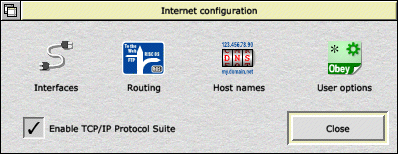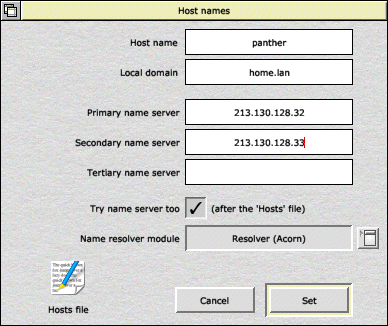These instructions are designed to help you configure your Iyonix computer to communicate with other machines, either in your home/office or across the internet via a broadband router.
Computers 'talk' to each other via a protocol known as TCP/IP (Transmission Control Protocol/Internet Protocol) which require certain settings to be made so that each computer can identify each other and send data between them. You need to do this whether you're connecting two computers together in the home or office, or communicating with a distant machine across the internet via a broadband router.
These instructions give a step-by-step tutorial on how to setup the RISC OS end of things and assume that you're using RISC OS 5 on the Iyonix computer. If you're using another version of RISC OS, please return to the networking page and select the correct version of RISC OS.
| 1. | Firstly, make yourself a nice cup of tea and sit down in front of your Iyonix. For the purposes of these instructions, we'll assume that you want to connect to a broadband router. If you wish to network to another RISC OS computer, just follow these instructions for each machine simply changing the relevant IP address and host names. |
| 2. | Double-click on !Boot to load the configuration setup. |
| 3. | Click on Network. This should open a small Network configuration window containing three icons (fig.1). Fig.1 |
| 4. | Click on the AUN icon and make sure the 'Enable AUN' icon is turned off (ie. no tick) and click 'Set'. |
| 5. | Click on the Access icon and make sure 'Enable Access' is ticked ON. Click 'Set'. This will enable ShareFS so that you can share drives on any RISC OS machines connected to your network. If you don't want to share discs between multiple RISC OS machines, you can turn this off (untick). |
| 6. | Click on the Internet icon. This opens the Internet configuration window (fig.2) which is a bit more complex. Fig.2 |
| 7. | Firstly, ensure that the 'Enable TCP/IP Protocol Suite' is turned on by clicking on it's icon if neccessary. |
| 8. | Click on the Interfaces icon. This will open the Interfaces window and you should find that your relevant network card is ticked. In the example here it says "Intel PRO/1000", which is the default network card in the Iyonix. Fig.3 |
| 9. | Click on the Configure icon (to the right, fig.4) and a network card configuration window should open. Fig.4 |
| 10. | In this window you need to enter an IP address and a Netmask. The IP address should be unique for each machine on your network. Before deciding what your IP address should be, it may be advisable to read our simple guide to IP addresses.
In conjunction with the netmask, the IP address determines which machines your computers can communicate with. If you get either wrong, then you won't be able to communicate between the devices. Most broadband routers come preset with an IP address of something like 192.168.1.1, with a subnet of 255.255.255.0.
In a nutshell, the netmask determines which bits of an IP address are fixed, or variable. 255 means the bits are fixed, and 0 means they can vary. Thus, if all your devices have a netmask of 255.255.255.0 it means that the first three numbers of the IP address have to be the same on all the machines you want to communicate with. Thus, if your router is 192.168.1.1 you could safely set your computer's IP address to 192.168.1.2 and if you had a second computer, set that IP address to 192.168.1.3 - as long as the first three numbers are the same, and the last digit is unique. If two computers on the same subnet (in this case the subnet is 192.168.1) have the same IP address, they will clash and your network won't work.
As you can see from the screenshot above, I've configured my subnet to 10.1.1 and my Iyonix is assigned address 50 on that subnet - hence the IP address of 10.1.1.50. This works because I've also changed the IP address of my broadband router to start with 10.1.1. too.
Suffice to say that you don't really need to understand all the ins and outs, as long as you remember that 255's in the netmask mean the number of the IP address in that position is fixed, and 0 means it's variable. For a more detailed explanation, read our simple guide to TCP/IP. |
| 11. | Thus, for the reasons above, ensure the Netmask to 255.255.255.0
Again, see our guide on TCP/IP for more info. |
| 12. | Underneath these two settings there should be a box labelled Obtain IP address and six selectable icons. Make sure the one labelled manually is ticked and all the others are off. |
| 13. | Ensure that the Primary interface icon is ticked. |
| 14. | Click Set. |
| 15. | Having clicked Set, click Close in the Interfaces window. |
| 16. | Now click on Routing in the Internet configuration window (fig.2). This doesn't need to be used in a simple network between local computers, so you can just confirm that the Gateway icon is blank and all the options are turned off.
However, if you're connecting to broadband, you should set the gateway to the IP address of your router (in the example here, 10.1.1.254 but may be 192.168.1.1 depending on your router). Fig.5 Leave the two icons at the bottom turned off (unticked) and click Set to close the window. |
| 17. | Back in the Internet Configuration window (fig.2), click on Host names. This opens a largish Host names window (fig.6) containing a number of writable icons. Fig.6 |
| 18. | Ensure that the Try name server too option (towards the bottom) is ticked, otherwise several of the editable icons will be greyed out. |
| 19. | In the Host name icon enter a name by which your computer will be known on your network. This can be an English name that you can remember. I've called mine "panther". However, different people choose different naming conventions for their individual machines. Some choose Tolkien characters, or Solar System planets, or trees etc. In the example here, I've been unoriginal and just called the Iyonix panther (as it's a Panther model). Each computer on your local network needs a unique name.
N.B.Some email clients add the hostname to email headers, so you can always enter something like "Anonymous" if you don't want anyone else to identify your hostname. |
| 20. | For the Local domain enter a name for your local area network (LAN). I'd recommend something like home.lan
Some people recommend putting your ISP domain here, such as orpheusinternet.co.uk but I've found that home.lan works just as well, and is more anonymous. |
| 21. | You should set the Primary name server and Secondary name server to those provided by your ISP. In the example here I'm connecting to Orpheus Internet so I've set to their DNS/name server addresses. Some people recommend setting the primary name server to that of the broadband router itself (which you can do), but my personal preference is to use the ISPs name servers directly. |
| 22. | Set the Name resolver module to Resolver (Acorn) via the small menu icon to the right of the main icon. |
| 23. | Double click on the Hosts file... icon in the bottom left corner. This will load the Hosts file into a text editor so that you can manually enter all the machines connected together on your network. |
| 24. | Scroll right down to the bottom and it should end in a line saying something like 127.0.0.1 loopback localhost loghost |
| 25. | At the end of the file enter the IP addresses (as entered at step 10) and host names (as entered at step 19) for each computer that you're linking together. Each entry should be on it's own line. My hosts file looks something like:-

Each IP address and host name should be seperated by a single TAB character.
The purpose of the Hosts file is explained in a bit more detail in our guide to TCP/IP networking. |
| 26. | Close and Save the hosts file. |
| 27. | Click Set in the Host names window. |
| 28. | Click Close in the Internet configuration window (no need to worry about the User options icon. |
| 29. | Click Save in the Network configuration window. The computer will now ask you if you want to reset the computer in order for the settings to take place. Reset the machine and your Iyonix TCP/IP settings should now be configured correctly. |
| 30. | You can repeat the steps above for each RISC OS machine on your network. |
If you wish to add a comment to this article, please use the form below. Please note that by submitting comments using this form you are allowing all of the information submitted to be visible on this website. Your comment will be published immediately, so please proof-read before you add. Any comments deemed to be abusive or irrelevant to the topic of the article may be removed without warning.






